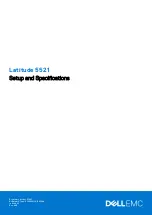
engine, a scheduled persistent image is created only as long as that engine
owns the volume at the time the scheduled persistent image is to occur.
To ensure that a scheduled persistent image will take place regardless of which
engine owns the volume, you must do the following:
1. Use the Schedules panel to create the schedule on the engine that currently
owns the volume.
2. Use the Cluster Administrator to move the disk group that contains the
volume to the other engine. You can create or edit a schedule only for a
volume on the engine that currently owns the volume. If an engine does not
own the volume, you cannot select the volume when creating a new schedule
through the New Persistent Image Schedule panel (under Schedules).
3. Use the Schedules panel on the other engine to create the same schedule
that you created on the original engine, with all of the same parameters (start
time, frequency, number to keep, and so on).
4. Use the Cluster Administrator to move the disk group that contains the
volume back to the original engine.
v
Volume restore of the system volume (C: drive) is not supported. If you attempt
to restore a persistent image containing the system volume, the restore operation
will not take place.
v
Volume restore of a data volume might require a reboot of the node. You will be
notified by the Restore Persistent Images panel whether a reboot is required
after a restore operation is initiated.
v
When you restart the NAS Gateway 300 (“restart” in this case means that with
both nodes down, the node that was shut down last is restarted first so that it
initially owns all of the shared data volumes), Persistent Storage Manager (PSM)
takes two actions:
1. Loading
2. Mapping
During loading, PSM loads existing persistent images from the cache files on
each of the volumes. The loading time depends on the amount of cache data
there is to read. Cached data is used by PSM to maintain the persistent images,
and the more cache data there is, the longer it takes to load the persistent
images, and thus the longer it might take the NAS Gateway 300 to become fully
operational after a restart.
During mapping, PSM makes the loaded persistent images accessible through
the file system by mounting each of them as a virtual volume underneath the
persistent images directory on the real volume for which the persistent image
was created. Mapping takes place five minutes after the real volume has been
mounted. The mapping time varies with the number of persistent images, as well
as the size of the volume.
As an example, suppose that on your NAS Gateway 300, you defined a 1 TB
volume with 50 percent of the volume allocated to the cache (500 GB cache),
and that you had 20 persistent images on the volume, using 100 GB (20 percent)
of the cache (based on the write activity to the volume since the first persistent
image was created). You would observe an increase in the startup time of
roughly 3 minutes, 20 seconds over what it would be without any persistent
images on the volume. Then, once the NAS Gateway 300 has become fully
operational, all 20 persistent images would become accessible within another 18
minutes (including the five minutes that PSM waits after the volume comes up to
begin the mapping).
Chapter 6. Managing and protecting the network and storage
71
Summary of Contents for TotalStorage NAS 300
Page 1: ...TotalStorage NAS Gateway 300 Model G27 User s Reference GA27 4321 00...
Page 8: ...viii NAS Gateway 300 User s Reference...
Page 10: ...x NAS Gateway 300 User s Reference...
Page 14: ...xiv NAS Gateway 300 User s Reference...
Page 26: ...12 NAS Gateway 300 User s Reference...
Page 40: ...26 NAS Gateway 300 User s Reference...
Page 46: ...32 NAS Gateway 300 User s Reference...
Page 68: ...54 NAS Gateway 300 User s Reference...
Page 134: ...120 NAS Gateway 300 User s Reference...
Page 136: ...122 NAS Gateway 300 User s Reference...
Page 168: ...154 NAS Gateway 300 User s Reference...
Page 182: ...168 NAS Gateway 300 User s Reference...
Page 199: ......
Page 200: ...Printed in U S A GA27 4321 00...
















































